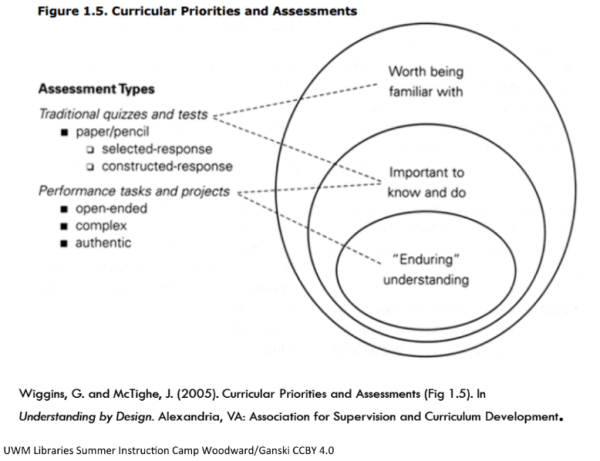It’s important for all of us to get feedback and the timeliness of feedback matters too. Remember how it felt when you submitted something to your doctoral thesis committee to review and they took FOREVER to get back to you? Or when you posted that picture on Facebook and the folks you thought would love it didn’t even give it a like let alone a comment? Timely feedback to students is useful to their learning and could be that thing that helps them feel like they belong at Carleton.
When designing or revising your course, one way to situate the types of feedback you’ll give is by using the classic Backward Design model by Wiggins and McTighe. Specifically, it can be helpful to use their diagram for setting curricular priorities into alignment with the types of assessment you might use. We can imagine that quizzing might best align with the concepts or outcomes that are important for students to know or to have facility with in order to wrestle with the BIG ideas or “enduring understanding” of a course.

Quizzing, and particularly multiple choice quizzing done outside the classroom (such as implemented via Moodle, auto-graded, and reported to the gradebook), can make frequent, meaningful feedback for students not only possible but efficient.
Frequent low stakes “testing” (i.e. the need to retrieve information whether in a quiz or otherwise) promotes learning (Roediger and Butler 2011). Moreover, frequent quizzing, besides promoting memory, increases the likelihood of transfer (Carpenter 2012).
You can also give feedback on these quizzes. The same Roediger and Butler–but this time in 2008–showed that while multiple choice questions improve student performance, feedback to students on their answers provides additional benefit. If that feedback is explanatory as to why an answer is wrong the transfer effect is stronger than simple feedback saying the answer is wrong (Moreno and Mayer, 2005).
Crafting feedback is decidedly not efficient though! But…it may still be worth your effort in terms of student learning, and if you reuse the quizzes your time investment will pay off. Moodle can help here too by making it easy to add feedback specific to each of the possible choices students can make in the quiz. And if you’re teaching a course that uses a textbook you should be aware than many textbooks provide banks of questions with answers and feedback and this can certainly lighten your load.
As always, AT is here to help you if you want to consider this pedagogical move. Please don’t hesitate to reach out to me (jrussell@carleton.edu) or any ATer if you have questions or concerns or would like to work with us!
Citations:
Butler AC and Roediger HL III (2008). Feedback enhances the positive effects and reduces the negative effects of multiple-choice testing. Memory and Cognition 36, 604-616.
S.K. Carpenter (2012),Testing enhances the transfer of learning, Current Directions in Psychological Science (Sage Publications, Inc), 21(5).
Moreno and R.E. Mayer (2005), Role of guidance, reflection, and interactivity in an agent-based multimedia game, Journal of Educational Psychology 97(I).
Roediger HL III and Butler AC (2011). The critical role of retrieval practice in long-term retention. Trends in Cognitive Sciences 15, 20-27.
Wiggins, Grant P., and Jay McTighe (2011). The Understanding by Design Guide to Creating High-Quality Units. Alexandria, Va: ASCD.
Add a comment